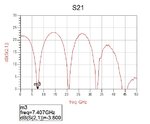mycw
Junior Member level 3
Hello everyone,
I'm trying to measure S21 of TIA in ADS, where s2p file is given, but I found from S21 response some unexpected periodical attenuations and I couldn't figure out the reason. Does anyone have a clue?
Testing circuit and S21 response are attached. Except the terminal for s-parameter measurement was added by me, remaining lump element values were recommended values from TIA manufacturer.
Thanks a lot!
Mario Young


I'm trying to measure S21 of TIA in ADS, where s2p file is given, but I found from S21 response some unexpected periodical attenuations and I couldn't figure out the reason. Does anyone have a clue?
Testing circuit and S21 response are attached. Except the terminal for s-parameter measurement was added by me, remaining lump element values were recommended values from TIA manufacturer.
Thanks a lot!
Mario Young
